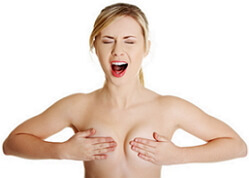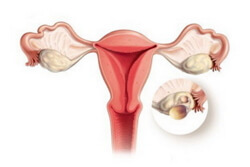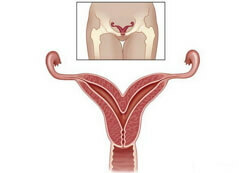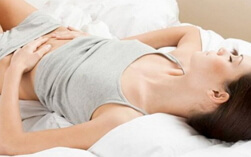Mastopathy treatment
 Treatment of mastopathy is the use of various medical methods to eliminate pathological processes in the mammary glands. The methods of treatment of mastopathy consist in carrying out of medicinal therapy and surgical methods of treatment. In forms of mild degree of mastopathy, anti-inflammatory drugs, preparations of homeopathic origin and phytotherapy are used. At forms of average severity of a mastopathy, after the spent inspection, resort to purpose or appointment of hormonal therapy. And when expressed forms - to a mixed treatment option, which includes: anti-inflammatory, hormonal therapy and surgical treatment.
Treatment of mastopathy is the use of various medical methods to eliminate pathological processes in the mammary glands. The methods of treatment of mastopathy consist in carrying out of medicinal therapy and surgical methods of treatment. In forms of mild degree of mastopathy, anti-inflammatory drugs, preparations of homeopathic origin and phytotherapy are used. At forms of average severity of a mastopathy, after the spent inspection, resort to purpose or appointment of hormonal therapy. And when expressed forms - to a mixed treatment option, which includes: anti-inflammatory, hormonal therapy and surgical treatment.
Fibrous mastopathy treatment
Treatment of fibrotic mastopathy involves the use of vitamin-mineral complexes. Vitamin supplements can normalize metabolism and hormonal balance. They promote the maturation and reproduction of epithelial cells, improve the work of the central nervous system and have an antioxidant effect. The vitamins A, E, and C.
have a particularly good effect on the treatment of fibrotic mastopathy. To suppress excessive growth of tissues in the mammary glands, minimal doses of iodine( an aqueous solution of potassium iodide) are administered throughout the entire cycle before the onset of menstruation. The course of treatment is one year.
In some patients, fibrous mastopathy manifests itself in the form of swelling of the hands and feet in the period before menstruation. In this regard, appoint diuretic drugs to remove excess fluid. A salt-free diet lasting a week is useful.
The administration of non-steroidal anti-inflammatory drugs can relieve seizures of mastalgia. They are appointed a few days before the onset of pain in the mammary gland. Since long-term treatment NVNS is unacceptable due to the occurrence of undesirable side effects, fibrotic mastopathy can be corrected by the appointment of drugs that improve the microcirculation of the outflow of venous blood. Sedation medications are prescribed for patients with psycho-emotional stress.
Treatment of fibrotic mastopathy of the breast requires adherence to a certain nutritional composition. Recent studies have revealed a link between the use of caffeine in high amounts and the development of fibrous mastopathy with the formation of cysts.
Fibrous mastopathy also has a certain relationship with chronic constipation, in which there is a violation in the composition of normal intestinal microflora, which is characterized by stagnant processes. For example, with constipation, there is a reverse absorption of estrogens, which are already excreted with bile, which increases their level in the blood.
It is known that one of the main reasons for the development of fibrotic mastopathy is hyperestrogenism. Therefore, the treatment should include the use of a large amount of fiber together with food( vegetables in raw form, fruits, fresh herbs, freshly squeezed juices) and at least two liters of clean water. The liver contributes to the utilization of steroid hormones, as well as estrogens, so it is necessary to provide a minimum load on the liver, excluding consumption of fatty, smoked food and alcohol. Support the work of the liver can be supplements with vitamins of group B.
Sports activities have a positive effect on blood circulation in the body, including in the mammary glands, thus eliminating stagnation in tissues and organs. The choice of a bra is also important in the treatment of fibrotic mastopathy, especially for those patients who have breast engorgement and mastalgia. Wrong selection of a bra or lack of it can lead to deformity of the mammary glands and the development of fibrous mastopathy. Properly selected bra should not bring uncomfortable sensations.
The appointment of combined oral contraceptives is justified when there are pronounced clinical manifestations of fibrotic mastopathy. It is important to take into account the dosage in the appointment of OK.Estradiol in them should not exceed 0.03 mg. These drugs include: Lyndinet 30, Jeannine, etc. The appointment of hormonal drugs should be carried out only after a comprehensive survey. It can include: collection of anamnesis, mammologist examination, mammography, breast ultrasound, thermography, cytological examination of nipple discharge, breast biopsy, CT and MRI.
Treatment of cystic mastitis
Treatment of cystic mastopathy is performed taking into account the course of the disease, the functional activity of the ovaries, the severity of proliferative processes.
Effective treatment of mastopathy in the cystic form is a complex approach, which involves the use of surgical and conservative methods.
When using the surgical method in the treatment of cystic mastopathy, the puncture needle is inserted into the cyst cavity under the control of the ultrasonic sensor and aspiration of the contents of the cyst is performed. There is a gluing of the cyst that does not allow it to form again. After the operation, the contents of the cyst are sent for examination to cytology in order to exclude the presence of atypical cells. Since, in most cases, cystic mastopathy is combined with severe fibrosis of the tissues, in addition to surgical treatment, hormone therapy is prescribed. It is also justified to prescribe such therapy in the presence of numerous small cystic cavities in the tissues of the mammary glands.
In the treatment of cystic mastopathy, progesterone derivatives( gestagens), testosterone derivatives( androgens), combined contraceptives with an active estrogen content of not more than 0.03 mg, antiprolactin drugs and antiestrogens are used. In addition to hormonal therapy, vitamin therapy and iodine preparations are prescribed. As with other forms, with cystic mastopathy a special role in treatment is given to a diet with a reduced content of carbohydrates and fat. Preference is given to raw vegetables and fruits, fish, meat and whole grain products.
The most effective methods of treatment of mastopathy of the cystic form include the use of gestagens and combined oral contraceptives. The gestagens can inhibit the gonadotropic function of the pituitary gland. They also have an anti-estrogenic effect in the tissues of the mammary glands. Assign them to the luteal phase of the cycle, which also significantly reduces the clinical manifestations of cystic mastopathy in the form of engorgement of the mammary glands and swelling.
Oral contraception is considered the most "harmless" in the treatment of cystic mastopathy of the breast. The duration of the OK reception is set by each woman for herself, but it is necessary to take a break in taking these medications once a year for a month.
Treatment of diffuse mastopathy
Treatment of diffuse mastopathy involves the use of only conservative therapy, as in diffuse mastopathy, the pathological process covers almost the entire breast tissue.
The processes of development of diffuse mastopathy occur under the influence of sex hormones. The most active are: estrogen, androgen, progesterone and prolactin. The metabolic processes that occur in the body also affect the hyperplasia of the tissues in the mammary gland. At the heart of all forms of mastopathy are disorders at the hormonal level, which explains the cyclical nature of clinical manifestations in diffuse mastopathy. In most cases, diffuse mastopathy is combined with gynecological pathologies( hyperplasia and polyps of the endometrium, endometriosis, myoma of the uterus body, etc.), therefore treatment of diffuse mastopathy of the breast must take place in conjunction with the correction of the background disease.
Treatment of diffuse breast mastopathy involves the appointment of antiestrogens, gestagens and some combined oral contraceptives. Tamoxifen or Toremifene can block receptors in the mammary glands, which decreases the biological activity of estrogen, which can not have a pathological effect on the tissues in the mammary gland. Also, antiestrogens can reduce the manifestations of mastalgia, normalize the menstrual cycle and reduce the amount of menstrual blood. But their long use is inexpedient because of the risk of developing endometrial hyperplasia, and, as a consequence, endometrial cancer.
Properly selected oral contraception in the treatment of diffuse mastopathy can also give good results. After the beginning of the use of COC in patients, oppression of the appearance of estrogen receptors in the mucous membrane of the uterus, the elimination of clinical manifestations of diffuse mastopathy, the normalization of the menstrual cycle were noted. The gestagens can slow down the synthesis of estrogens in the tissues of the mammary glands.
Not so long ago for the treatment of diffuse mastopathy, testosterone derivatives( Norgestel, Dinazol, Linestrinol) were prescribed, but progesterone derivatives have recently proved themselves. The latter have better gestagenic properties and low anti-estrogen activity.
Treatment with hormonal therapy for diffuse mastopathy should last at least 2 months for the appearance of a positive result from treatment. In 85% of cases there is a decrease in tissue hyperplasia in the mammary glands. Therapy against the background of androgens is explained by the ability to lower the synthesis of gonadotropic hormones. But against the background of androgen therapy, undesirable side effects often occur in the form of excessive growth of hair on the body and face, weight gain, voice timbre. With an increased level of prolactin, inhibitors of prolactin production are prescribed.
Along with hormone therapy, the prerequisite is the appointment of vitamins and a diet with a high content of fiber. To vitamin therapy can be attributed the appointment of B vitamins, which, in addition to beneficial effects on the liver, also have a beneficial effect on the central nervous system. Vitamins E, C and A have a powerful effect on the hormonal background of the female body, normalizing the menstrual cycle and suppressing the development of atypical cells in tissues.
When dieting is important, it is important to completely eliminate the consumption of fatty, smoked and fried foods, because the use of such food makes it difficult for the liver to work, which leads to poor metabolism of estrogen in it. To improve metabolism, it is important to include in your diet fresh vegetables and fruits, freshly squeezed juices and bread from wholemeal flour. Whole-grain cereals will also be a very good addition to such a diet. It is important to divide the food into five parts and drink at least 1.5-2 liters of water between them. It is worth noting that maintaining such a diet will have a beneficial effect on reducing body weight, thus on the appearance of a woman. Because, high body weight is a provoking factor for the development of liver diseases, pancreas, hypertension and menstrual irregularities.
Treatment of nodal mastopathy
Treatment of nodular mastopathy consists in surgical removal of the nodes in the mammary gland with the subsequent prevention of their occurrence. With nodular mastopathy, fibroadenoma, cyst, intraprostatic papilloma, leaf-like tumor, lipoma, lipogranuloma, angioma or hamartoma are isolated.
The use of hormone therapy is indicated only for the correction of the menstrual cycle, the elimination of clinical symptoms of concomitant gynecological diseases. But hormone therapy should be prescribed very carefully and under the control of an oncologist, because some types of hormones can provoke a rapid growth of the node in nodal mastopathy. The relationship between gynecological tumor diseases and nodal mastopathy has been established.
Effective treatment of mastopathy with nodular form consists in excision of the pathological node in the mammary gland with preservation of the organ. The volume and duration of the operation depends on the form and severity of the pathological process. In the presence of cysts, puncture aspiration of their contents is carried out followed by a cytological examination of the aspirate. Often, such manipulation is carried out in stationary-ablator conditions and the patient is released home on the same day. Apply local anesthesia as with biopsy of breast tissue. After such a procedure, the cyst recurrence is no more than 10%.But if after a while the cyst is formed again, then the enucleation of the formation is produced.
Treatment of fibroadenoma, lipoma, or other similar sites involves the implementation of sectoral resection. When it is cut out the affected part of the breast. Many women have concerns about such manipulation, therefore they initially resort to the appointment of homeopathic medicines and herbal medicine. But as studies have shown, nodal mastopathy by itself will not pass and knots in the mammary gland will not undergo regression. Therefore, in any case, especially if a controversial question arises about the goodness of the node or its rapid growth is observed, sectoral resection is carried out. May appoint Mastodion for 6 months, or Stella for 4-6 months. It is also widely used drops or infusion from the bovine uterus for 6-12 months. Such therapy can ease the clinical manifestations of nodal mastopathy( aching, drawing pains in the mammary gland) and restrain the growth of education.
If in case of nodular mastopathy it is a question of multiple formations, mixed character of formations, intraprostatic papillomas, then radical radical resection is used. It is carried out under full anesthesia, as well as sectoral resection. Only with radical resection is removed all affected by the nodes and formations of the mammary gland. The recovery period after radical or sectoral resection is from 14 to 28 days. Includes the appointment of vitamins, observance of fractional nutrition and consumption of a large number of fruits and vegetables. Consumption of liquid per day should not be less than 2 liters. With the help of mammoplasty, you can return the old type of breast six months after the operation.
In order to prevent nodal mastopathy, you should avoid direct sunlight, hikes in the sauna or bath, drinking alcohol and smoking.
Preparations for the treatment of mastopathy
Treatment of mastopathy of the breast often consists in prescribing medications. These include, in the first place, hormonal drugs.
Hormonotherapy is primarily aimed at reducing the effect of estrogens on breast tissue, its other action is the correction of hypothyroidism and dispropylactinemia.
Hormonal drugs are divided into several groups.
♦ The first group includes anti-estrogens. In order to provide a stimulating effect, estrogens need to enter into a relationship with specific cell receptors. With relative hyperestrogenesis, antiestrogens do not allow estrogens to bind to these receptors, reducing their biological activity. Antiestrogens also block estrogen receptors in such tissues that still act as targets( mammary glands, uterus, ovaries).There is evidence that anti-estrogens( Tamoxifen, Toremifene) have been used since the late 1970s. The therapeutic effect in the appointment of Tamoxifen is observed in 75-80% of cases and manifests itself after two months from the beginning of admission. Tamoxifen is prescribed at a dose of 10 mg per day. Some methods of treatment of mastopathy are the appointment of 20 mg per day of Tamoxifen ten days before the expected menstruation, continuing to take during 3 menstrual cycles.
When using a similar regimen, mastalgia is eliminated in 98% of cases. In addition to eliminating mastalgia, there is a stabilization of the menstrual cycle and a decrease in blood loss in menstruation in almost all patients. But in a certain number of patients, a feeling of bursting in the chest and pain syndrome in the first weeks after treatment is possible, which is explained by the estrogenic action of Tamoxifen. In exceptional cases, it is even necessary to interrupt treatment because of similar side effects, after which they pass quickly enough. Also, Tamoxifen is successfully used in the treatment of mastodynia in a dosage of 10 mg with 5-24 days of the cycle. In the presence of cancer in one mammary gland, the use of Tamoxifen significantly reduces the likelihood of developing cancer in another mammary gland. First of all, it concerns those patients who have proven atypical proliferation, macrocysts and hereditary factors. But some experts argue that the appointment of Tamoxifen, as a method of treatment of mastopathy, should be used only in special cases.
Like any medication, antiestrogenic drugs have side effects. These include, in addition to the aforementioned mastalgia in the first weeks of treatment, hyperhidrosis, hot flashes, dizziness and nausea. In the literature there are references to the presence of carcinogenic properties of antiestrogens. With their long-term use, it is possible to develop endometrial cancer or induced endometrial hyperplasia, hepatocellular carcinoma of the liver. Therefore, it is worthwhile to correctly determine the duration of treatment and correctly prescribe the dosage of antiestrogens. The minimum duration of treatment is three months.
♦ The second group of drugs used to treat mastopathy of the breast, include oral contraception. Correctly selected oral contraception has a constant suppression of ovulation and steroidogenesis, suppression of ovarian androgen production, suppression of estrogen receptor production, equalization of expressed fluctuations of sex hormones. In addition, oral contraception provides a long-term protection against the development of cancer of the uterus and ovaries.
Symptoms of mastopathy can be significantly reduced or completely stopped two months after the start of OK reception, but real objective data can be expected no earlier than one year after the beginning of admission. Despite such positive qualities of oral contraception, some women have noted an increase in symptomatic signs of mastopathy and the emergence of new symptoms. Then it is worthwhile to raise the question of replacing the drug or selecting another method of treating mastopathy.
When choosing an oral contraceptive, the dosage of active components and their properties are important. Given the main role in the development of estrogen mastopathy, it is necessary to give preference to those contraceptives where there is a high content of progestins( 0.075 mg) and a low content of estrogens( 0.03 mg).
The duration of oral contraceptive use in the treatment of mastopathy should be prescribed for a period of at least three months. The drugs of choice for mastopathy are: Jeannine, Lyndinet 30, Regulon, Novinet, etc. The appointment of such hormonal drugs as mini-drunks is inexpedient, because the dose of hormones in them is extremely low.
When appointing an oral contraceptive it is necessary to take into account the chronic diseases of a woman, her age, severity of mastopathy and the presence of bad habits. So OK application has a number of relative contraindications, which include: age over 35 years and smoking more than 15 cigarettes a day, varicose veins, liver disease, hypertension. Absolute contraindications are: thromboembolism, severe liver and kidney disease, history of a heart attack, a previous stroke. In a certain number of patients with mastopathy, the use of OK does not give the expected result, so they can additionally prescribe Primolut 2.5 mg or Medroxyprogesterone acetate 5 mg from 16-25 days of the cycle, throughout the oral contraceptive intake.
♦ The third group of drugs for the treatment of mastopathy are gestagens. Their therapeutic effect in the treatment of mastopathy and premenstrual syndrome is based on the inhibition of pituitary-ovarian connections of a functional nature and a decrease in the proliferation of estrogens in the tissues of the mammary glands.
It is not known whether gestagens are prophylaxis for breast cancer, because they are used only for the treatment of breast mastopathy and certain hormone-specific gynecological diseases.
Today, the use of progesterone derivatives( Medroxyprogesterone acetate( MPA)) is widely used because they have more pronounced gestagenic properties, moderate antiestrogenic activity and almost no androgenic effect. All the more justified is the appointment of gestagens to those patients who have luteal phase failure with such manifestations as: anovulatory bleeding, hyperestrogenia, uterine myoma. In case of such violations, Norethysterone 5 mg, 10 Mg MPA is prescribed from 15-25 days of the cycle, synchronizing treatment courses with at least six cycles.
To create an additional anti-estrogenic effect before ovulation, it is desirable to use gestagens from 10-25 days of the cycle. For blockade of ovulation, such drugs can begin with 5-25 days of the cycle. In the period of menopause gestagens are appointed in the mode of smooth reduction of dosage. For example, begin with MPA 10 mg for a month, then MPA 5 mg for two weeks, then MPA 5 mg every other day. The positive effect of the use of gestagens can already be expected in 80% of cases, it occurs within two months. In addition to the fact that gestagens are good in the treatment of mastopathy, after their use, it is possible to confirm the reduction of breast tissue.
♦ The fourth group of drugs in the treatment of mastopathy include Danazol. It is based on the ability to suppress the synthesis of gonadotropic hormones and certain hepatic enzymes in ovarian steroidogenesis. It also has a progestogenic and not strongly pronounced androgenic effect.
Danazol in the treatment of mastopathy is used in not such high dosages that when treating endometriosis. A dosage of 100 to 400 mg is considered standard. A positive therapeutic effect occurs in 75% of cases. When X-ray examination of the mammary glands after treatment with Danazol, the mammary gland tissue decreases and aligns. Repeated formation of macro-cysts is much less frequent. Many experts consider Danazol as the drug of choice for the treatment of recurrent macrocysts. When treating Danazol, there are side effects in a quarter of cases. These may include: hirsutism, seborrhea, acne, changes in voice, weight gain, hot flashes, migraine, depression, seizures. When using Danazol in a dose of 400 mg in patients, amenorrhea occurs. Danazol does not have a contraceptive effect in the dose of 200-400 mg, therefore it is necessary to apply additional measures of contraception, because this drug has a teratogenic effect. Given the occurrence of undesirable side effects, many specialists prefer Danazol in small doses: 200 mg / day for the first two months, 100 mg / day for the next two months, then 100 mg / day from 14-28 days of the cycle.
♦ The fifth group of drugs for the treatment of mastopathy include inhibitors of prolactin production. These drugs include bromocriptine, which is prescribed to patients who have been proven to have hyperprolactinaemia laboratory. The level of prolactin in the blood should be determined after the so-called TRH test. The dosage of bromocriptine is usually from 5 mg to 7.5 mg under the control of prolactin levels. Bromocriptine, despite its effectiveness, also has unpleasant side effects, such as: dizziness, alopecia, puffiness, migraine.
♦ The last group of drugs for mastopathy includes LHRH analogues. As a result of their use, the level of testosterone and circulating estrogens is significantly reduced. In addition, the presence of LHRH analogs in breast tissue and fibrotic mastopathy allows one to think about their specific effect on the growth of breast tissue. The main evidence for treating such drugs is severe refractory cystic mastopathy.
Treatment with LHRH analogs is an expensive and not very safe method, due to the development of side effects: amenorrhea, hot flashes, dizziness, hypertension. Indications for their application should be carefully thought out in each case. Nowadays, the use of LHRH analogues is resorted to when hormonal therapy has not shown a pronounced therapeutic effect.



